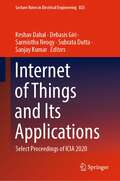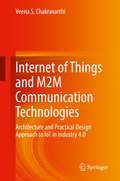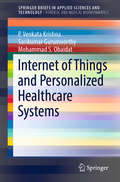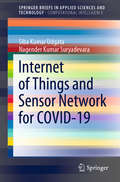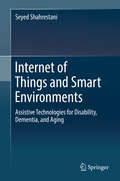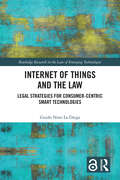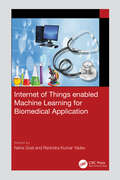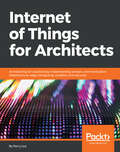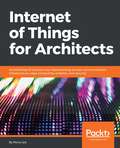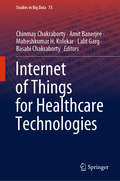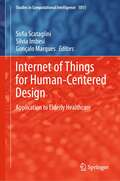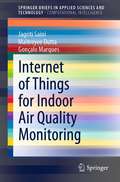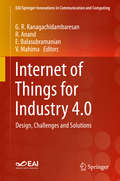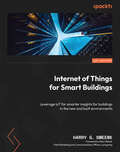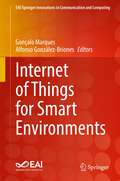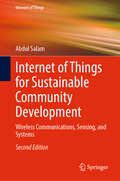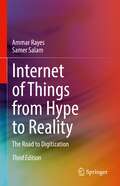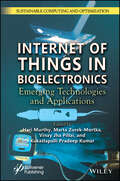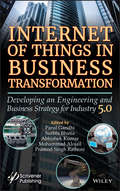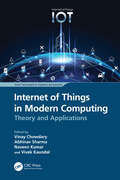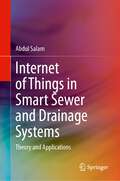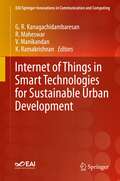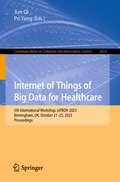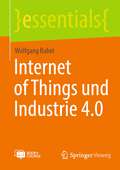- Table View
- List View
Internet of Things and Its Applications: Select Proceedings of ICIA 2020 (Lecture Notes in Electrical Engineering #825)
by Sanjay Kumar Debasis Giri Sarmistha Neogy Keshav Dahal Subrata DuttaThis volume constitutes selected papers presented at the International Conference on IoT and its Applications 2020. The research papers presented were carefully reviewed and selected from several initial submissions on the topics - the Internet of Things (IoT) and its applications such as smart cities, smart devices, agriculture, transportation and logistics, healthcare, etc. The book contains peer-reviewed chapters written by leading international scholars from around the world. This book will appeal to students, practitioners, industry professionals, and researchers working in the field of IoT and its integration with other technologies to develop comprehensive solutions to real-life problems.
Internet of Things and M2M Communication Technologies: Architecture and Practical Design Approach to IoT in Industry 4.0
by Veena S. ChakravarthiThis book provides readers with a 360-degree perspective on the Internet of Things (IoT) design and M2M communication process. It is intended to be used as a design guide for the development of IoT solutions, covering architecture, design, and development methods. This book examines applications such as industry automation for Industry 4.0, Internet of Medical Things (IoMT), and Internet of Services (IoS) as it is unfolding. Discussions on engineering fundamentals are limited to what is required for the realization of IoT solutions. Internet of Things and M2M Communication Technologies: Architecture and Practical Design Approach to IoT in Industry 4.0 is written by an industry veteran with more than 30 years of hands-on experience. It is an invaluable guide for electrical, electronic, computer science, and information science engineers who aspire to be IoT designers and an authoritative reference for practicing designers working on IoT device development.Provides complete design approach to develop IoT solutions;Includes reference designs and guidance on relevant standards compliance;Addresses design for manufacturability and business models.
Internet of Things and Personalized Healthcare Systems (SpringerBriefs in Applied Sciences and Technology)
by Mohammad S. Obaidat Sasikumar Gurumoorthy P. Venkata KrishnaThis book highlights the issues and challenges in personalised healthcare systems. The individual chapters address different aspects of such systems, including the novel Internet of Things (IoT) system architectures in healthcare and emerging e-health based IoT applications. Moreover, the book investigates the impact of cutting-edge innovations on the IoT.
Internet of Things and Secure Smart Environments: Successes and Pitfalls (Chapman & Hall/CRC Big Data Series)
by Uttam Ghosh, Danda B Rawat, Raja Datta and Al-Sakib Khan PathanThe main goal of Internet of Things (IoT) is to make secure, reliable, and fully automated smart environments. However, there are many technological challenges in deploying IoT. This includes connectivity and networking, timeliness, power and energy consumption dependability, security and privacy, compatibility and longevity, and network/protocol standards. Internet of Things and Secure Smart Environments: Successes and Pitfalls provides a comprehensive overview of recent research and open problems in the area of IoT research. Features: Presents cutting edge topics and research in IoT Includes contributions from leading worldwide researchers Focuses on IoT architectures for smart environments Explores security, privacy, and trust Covers data handling and management (accumulation, abstraction, storage, processing, encryption, fast retrieval, security, and privacy) in IoT for smart environments This book covers state-of-the-art problems, presents solutions, and opens research directions for researchers and scholars in both industry and academia.
Internet of Things and Sensor Network for COVID-19 (SpringerBriefs in Applied Sciences and Technology)
by Nagender Kumar Suryadevara Siba Kumar UdgataThis book examines various models/solutions in areas, such as individuals, home, work and society, where IoT and AI are being utilized to mitigate the Covid-19 pandemic. The world is battling with the novel coronavirus, and government authorities, scientists, medical practitioners, and medical services are striving hard to help people to face the challenges. During this crisis, numerous innovative ideas and solutions have been proposed for using the Internet of things (IoT), sensor networks, and artificial intelligence (AI) to monitor the wellbeing of individuals. Nations are using all available assets to help develop cutting-edge innovations to relieve the impacts of Covid-19 and profile individuals in danger. The advances in IoT frameworks and sensor technologies together with AI are invaluable in the context of this pandemic, and nations and various entities around the globe are discovering innovative solutions to maintain businesses and help people live alongside Covid-19. This book presents the advances in sensor technologies, IoT frameworks, and explores how these technologies are being used to deal with the issues arising from Covid-19, including work in progress and potential applications.
Internet of Things and Smart Environments
by Seyed ShahrestaniThis book is focused on the Internet of Things (IoT) services and smart environments that can be of assistance to the elderly and individuals living with dementia or some sensory impairment. The book outlines the requirements of the systems that aim to furnish some digital sensory or cognitive assistance to the individuals and their caregivers. Internet of Things and Smart Environments: Assistive Technologies for Disability, Dementia, and Aging covers the important evolutions of the IoT, the sensors, actuators, wireless communication and pervasive computing systems, and other enabling technologies that power up this megatrend infrastructure. The use of the IoT-based systems in improving the conventional assistive technologies and provisions of ambient assisted living are also covered. The book takes an impartial, and yet holistic, view to providing research insights and inspirations for more development works in the areas related to assistive IoT. It will show the potentials of using normally available interactive devices, like smartphones or smart TVs, which can be supplemented with low-cost gadgets or apps to provide assistive capabilities. It aims to accentuate the need for taking a comprehensive and combinatory view of the comprising topics and approaches that are based on the visions and ideas from all stakeholders. The book will examine these points and considerations to conclude with recommendations for future development works and research directions. This book can be of value to a diverse array of audience. The researchers and developers in healthcare and medicine, aged care and disability services, as well as those working in the IoT-related fields, may find many parts of this book useful and stimulating. It can be of great value to postgraduate and research students working in these areas. It can also be adapted for use in upper-level classroom courses relevant to communication and smart technologies, IoT applications, and assistive technologies. Many parts of the book can be of interest to the elderly and individuals living with a disability, as well as their families and caregivers. From an industry perspective, it can be of interest to software, hardware, and particularly app developers working on the IoT applications, smart homes and environments, and assistive technologies for the elderly and people living with disability or dementia.
Internet of Things and the Law: Legal Strategies for Consumer-Centric Smart Technologies (Routledge Research in the Law of Emerging Technologies)
by Guido Noto La DiegaInternet of Things and the Law: Legal Strategies for Consumer-Centric Smart Technologies is the most comprehensive and up-to-date analysis of the legal issues in the Internet of Things (IoT). For decades, the decreasing importance of tangible wealth and power – and the increasing significance of their disembodied counterparts – has been the subject of much legal research. For some time now, legal scholars have grappled with how laws drafted for tangible property and predigital ‘offline’ technologies can cope with dematerialisation, digitalisation, and the internet. As dematerialisation continues, this book aims to illuminate the opposite movement: rematerialisation, namely, the return of data, knowledge, and power within a physical ‘smart’ world. This development frames the book’s central question: can the law steer rematerialisation in a human-centric and socially just direction? To answer it, the book focuses on the IoT, the sociotechnological phenomenon that is primarily responsible for this shift. After a thorough analysis of how existing laws can be interpreted to empower IoT end users, Noto La Diega leaves us with the fundamental question of what happens when the law fails us and concludes with a call for collective resistance against ‘smart’ capitalism.
Internet of Things enabled Machine Learning for Biomedical Application
by Neha Goel Ravindra Kumar YadavThe text begins by highlighting the benefits of the Internet of Things-enabled machine learning in the healthcare sector, examines the diagnosis of diseases using machine learning algorithms, and analyzes security and privacy issues in the healthcare systems using the Internet of Things. The text elaborates on image processing implementation for medical images to detect and classify diseases based on magnetic resonance imaging and ultrasound images.This book:· Covers the procedure to recognize emotions using image processing and the Internet of Things-enabled machine learning.· Highlights security and privacy issues in the healthcare system using the Internet of Things. · Discusses classification and implementation techniques of image segmentation.· Explains different algorithms of machine learning for image processing in a comprehensive manner. · Provides computational intelligence on the Internet of Things for future biomedical applications including lung cancer.It is primarily written for graduate students and academic researchers in the fields of electrical engineering, electronics and communications engineering, computer science and engineering, and biomedical engineering.
Internet of Things for Architects: Architecting IoT solutions by implementing sensors, communication infrastructure, edge computing, analytics, and security
by Perry LeaLearn to design, implement and secure your IoT infrastructure About This Book • Build a complete IoT system that is the best fit for your organization • Learn about different concepts, technologies, and tradeoffs in the IoT architectural stack • Understand the theory, concepts, and implementation of each element that comprises IoT design—from sensors to the cloud • Implement best practices to ensure the reliability, scalability, robust communication systems, security, and data analysis in your IoT infrastructure Who This Book Is For This book is for architects, system designers, technologists, and technology managers who want to understand the IoT ecosphere, various technologies, and tradeoffs and develop a 50,000-foot view of IoT architecture. What You Will Learn • Understand the role and scope of architecting a successful IoT deployment, from sensors to the cloud • Scan the landscape of IoT technologies that span everything from sensors to the cloud and everything in between • See the trade-offs in choices of protocols and communications in IoT deployments • Build a repertoire of skills and the vernacular necessary to work in the IoT space • Broaden your skills in multiple engineering domains necessary for the IoT architect In Detail The Internet of Things (IoT) is the fastest growing technology market. Industries are embracing IoT technologies to improve operational expenses, product life, and people's well-being. An architectural guide is necessary if you want to traverse the spectrum of technologies needed to build a successful IoT system, whether that's a single device or millions of devices. This book encompasses the entire spectrum of IoT solutions, from sensors to the cloud. We start by examining modern sensor systems and focus on their power and functionality. After that, we dive deep into communication theory, paying close attention to near-range PAN, including the new Bluetooth® 5.0 specification and mesh networks. Then, we explore IP-based communication in LAN and WAN, including 802.11ah, 5G LTE cellular, SigFox, and LoRaWAN. Next, we cover edge routing and gateways and their role in fog computing, as well as the messaging protocols of MQTT and CoAP. With the data now in internet form, you'll get an understanding of cloud and fog architectures, including the OpenFog standards. We wrap up the analytics portion of the book with the application of statistical analysis, complex event processing, and deep learning models. Finally, we conclude by providing a holistic view of the IoT security stack and the anatomical details of IoT exploits while countering them with software defined perimeters and blockchains. Style and approach This hands-on guide combines theory and application to the Internet of Things. This book covers the entire architectural stack of components and engineering domains from sensors to power analysis, communication systems, information theory, networking and routing, data security, protocols, software stacks, cloud mechanics, and data analytics with deep learning.
Internet of Things for Architects: Architecting Iot Solutions By Implementing Sensors, Communication Infrastructure, Edge Computing, Analytics, And Security
by Perry Lea<P><P>Learn to design, implement and secure your IoT infrastructure <P><P>Key Features <P><P>Build a complete IoT system that is the best fit for your organization <P><P>Learn about different concepts, technologies, and tradeoffs in the IoT architectural stack <P><P>Understand the theory, concepts, and implementation of each element that comprises IoT design―from sensors to the cloud <P><P>Implement best practices to ensure the reliability, scalability, robust communication systems, security, and data analysis in your IoT infrastructure <P><P>Book Description <P><P>The Internet of Things (IoT) is the fastest growing technology market. Industries are embracing IoT technologies to improve operational expenses, product life, and people's well-being. An architectural guide is necessary if you want to traverse the spectrum of technologies needed to build a successful IoT system, whether that's a single device or millions of devices. <P><P>This book encompasses the entire spectrum of IoT solutions, from sensors to the cloud. We start by examining modern sensor systems and focus on their power and functionality. After that, we dive deep into communication theory, paying close attention to near-range PAN, including the new Bluetooth® 5.0 specification and mesh networks. Then, we explore IP-based communication in LAN and WAN, including 802.11ah, 5G LTE cellular, SigFox, and LoRaWAN. Next, we cover edge routing and gateways and their role in fog computing, as well as the messaging protocols of MQTT and CoAP. <P><P>With the data now in internet form, you'll get an understanding of cloud and fog architectures, including the OpenFog standards. We wrap up the analytics portion of the book with the application of statistical analysis, complex event processing, and deep learning models. Finally, we conclude by providing a holistic view of the IoT security stack and the anatomical details of IoT exploits while countering them with software defined perimeters and blockchains. <P><P>What you will learn <P><P>Understand the role and scope of architecting a successful IoT deployment, from sensors to the cloud <P><P>Scan the landscape of IoT technologies that span everything from sensors to the cloud and everything in between <P><P>See the trade-offs in choices of protocols and communications in IoT deployments <P><P>Build a repertoire of skills and the vernacular necessary to work in the IoT space <P><P>Broaden your skills in multiple engineering domains necessary for the IoT architect <P><P>Who This Book Is For <P><P>This book is for architects, system designers, technologists, and technology managers who want to understand the IoT ecosphere, various technologies, and tradeoffs and develop a 50,000-foot view of IoT architecture.
Internet of Things for Healthcare Technologies (Studies in Big Data #73)
by Amit Banerjee Maheshkumar H. Kolekar Chinmay Chakraborty Lalit Garg Basabi ChakrabortyThis book focuses on recent advances in the Internet of Things (IoT) in biomedical and healthcare technologies, presenting theoretical, methodological, well-established, and validated empirical work in these fields. Artificial intelligence and IoT are set to revolutionize all industries, but perhaps none so much as health care. Both biomedicine and machine learning applications are capable of analyzing data stored in national health databases in order to identify potential health problems, complications and effective protocols, and a range of wearable devices for biomedical and healthcare applications far beyond tracking individuals’ steps each day has emerged. These prosthetic technologies have made significant strides in recent decades with the advances in materials and development. As a result, more flexible, more mobile chip-enabled prosthetics or other robotic devices are on the horizon. For example, IoT-enabled wireless ECG sensors that reduce healthcare cost, and lead to better quality of life for cardiac patients. This book focuses on three current trends that are likely to have a significant impact on future healthcare: Advanced Medical Imaging and Signal Processing; Biomedical Sensors; and Biotechnological and Healthcare Advances. It also presents new methods of evaluating medical data, and diagnosing diseases in order to improve general quality of life.
Internet of Things for Human-Centered Design: Application to Elderly Healthcare (Studies in Computational Intelligence #1011)
by Sofia Scataglini Gonçalo Marques Silvia ImbesiThe book presents the state of the art of the Internet of Things (IoT), applied to Human-Centered Design (HCD) projects addressed to ageing users, from the perspective of health, care and well-being. The current focus on the ageing population is opening up new opportunities for the development of niche solutions aimed at the niche category of older users who are beginning to experience physical and cognitive decline but are still independent and need to maintain their autonomy for as long as possible. The combination between the needs expressed by older users and the opportunities offered by the recent innovative technologies related to the Internet of Things allows research institutions, stakeholders, and academia to target and design new solutions for older users, safeguarding their well-being, health, and care, improving their quality of life. This book discusses and analyses the most recent services, products, systems and environments specifically conceived for older users, in order to enhance health, care, well-being and improve their quality of life. This approach is coherent with the percept of AAL or enhanced living environment, looking to the users’ comfort, autonomy, engagement and healthcare. The book describes and analyses aspects of HCD with older users looking to the emerging technologies, products, services, and environments analysed in their actual application in different areas, always concerning the design for the elderly related to the IoT, just as the development of biomonitoring devices, tools for activity recognition and simulation, creation of smart living environments, solutions for their autonomy, assistance and engagement enhancing health, care and wellbeing. The book is intended for researchers, designers, engineers, and practitioners in healthcare to connect academia, stakeholders, and research institutions to foster education, research and innovation.
Internet of Things for Indoor Air Quality Monitoring (SpringerBriefs in Applied Sciences and Technology)
by Maitreyee Dutta Gonçalo Marques Jagriti SainiThis book provides a synthesis for using IoT for indoor air quality assessment. It will help upcoming researchers to understand the gaps in the literature while identifying the new challenges and opportunities to develop healthy living spaces. On the other hand, this book provides insights about integrating IoT with artificial intelligence to design smart buildings with enhanced air quality. Consequently, this book aims to present future scope for carrying out potential research activities in this domain.Over the past few years, the Internet of Things (IoT) is proven as the most revolutionizing invention in the field of engineering and design. This technology has wide scope in automation and real-time monitoring. Indoor air quality assessment is one of the most important applications of IoT which helps in the development of smart and healthy living spaces. Numerous methods have been developed for air quality assessment to ensure enhanced public health and well-being. The combination of sensors, microcontrollers, and communication technologies can be used to handle the massive amount of field data to access the condition of building air quality.
Internet of Things for Industry 4.0: Design, Challenges and Solutions (EAI/Springer Innovations in Communication and Computing)
by G. R. Kanagachidambaresan R. Anand E. Balasubramanian V. MahimaThis book covers challenges and solutions in establishing Industry 4.0 standards for Internet of Things. It proposes a clear view about the role of Internet of Things in establishing standards. The sensor design for industrial problem, challenges faced, and solutions are all addressed. The concept of digital twin and complexity in data analytics for predictive maintenance and fault prediction is also covered. The book is aimed at existing problems faced by the industry at present, with the goal of cost-efficiency and unmanned automation. It also concentrates on predictive maintenance and predictive failures. In addition, it includes design challenges and a survey of literature.
Internet of Things for Smart Buildings: Leverage IoT for smarter insights for buildings in the new and built environments
by Harry G. Smeenk Marc PetockHarness the full potential of IoT in your building to improve living standards, energy efficiency, and morePurchase of the print or Kindle book includes a free PDF eBookKey FeaturesDiscover how IoT solutions transform mechanical and electrical control systems into smart systemsUnlock new revenue potential, operational efficiencies, and improved occupant's quality of lifeExplore industry thought leadership through author-led real-world applications and use casesBook DescriptionImagine working in a building with smart features and tenant applications that allow you to monitor, manage, and control every aspect of your user experience. Internet of Things for Smart Buildings is a comprehensive guide that will help you achieve that with smart building architecture, ecosystems, technologies, and key components that create a smart building.In this book, you'll start by examining all the building systems and applications that can be automated with IoT devices. You'll learn about different apps to improve efficiency, reduce consumption, and improve occupant satisfaction. You'll explore IoT sensors, devices, computing platforms, analytics software, user interfaces, and connectivity options, along with common challenges you might encounter while developing the architecture.You'll also discover how to piece different components together to develop smart buildings with the help of use cases and examples and get to grips with the various IoT stacks. After finding out where to start developing the requirements for your project, you'll uncover a recommended methodology to understand your current building systems and a process for determining what needs to be modified, along with new technology requirements.By the end of the book, you'll be able to design and build your own smart building initiative, turning your city into a smart city with one building at a time.What you will learnDiscover what's a smart building and how IoT enables smart solutionsUncover how IoT can make mechanical and electrical systems smartUnderstand how IoT improves workflow tasks, operations, and maintenanceExplore the components and technology that make a smart buildingRecognize how to put together components to deploy smart applicationsBuild your smart building stack to design and develop smart solutionsWho this book is forThis book is for architects, mechanical, electrical, and HVAC engineers, system integrators, facility, and operations personnel, and others looking to implement IoT solutions to make their buildings smart. Basic understanding of various mechanical and electrical building systems including HVAC, security, fire alarms, communications, and data networks as well as the operations and maintenance requirements is a prerequisite.
Internet of Things for Smart Environments (EAI/Springer Innovations in Communication and Computing)
by Alfonso González-Briones Gonçalo MarquesThis book aims to introduce recent advances in IoT and its applications for smart environments. The state of the art is reviewed with a focus on the technologies, applications, challenges, and opportunities. At this stage, a comprehensive understanding of the formal and practical applications of IoT in the different scenarios of smart environments is necessary to support future research. Therefore, the main contribution of this book is a comprehensive study of the most recent proposals for smart environments. In addition, this book synthesizes existing information and highlights common threads and gaps that lead to new and complex areas of future research. The book covers a range of major research subjects which will foster future implementations. The topics include smart learning environments, crowdsensing applications, participatory citizen sensing, multimodal perception systems and security challenges. This book seeks to provide a valuable framework for future research projects by expounding the topic to academics, engineers, and industry professionals, which is necessary for the design of future IoT architectures for smart environments.
Internet of Things for Sustainable Community Development: Wireless Communications, Sensing, and Systems (Internet of Things)
by Abdul SalamThis updated book presents research on how Internet of Things plays a part in shaping the future of our communities. The author shows how the research and education ecosystem promoting impactful solutions-oriented science can help citizenry, government, industry, and other stakeholders to work collaboratively in order to make informed, socially-responsible, science-based decisions. The author also provides updated data on how communities can address complex, interconnected socio-environmental challenges. This book addresses the key inter-related challenges in areas such as the environment, climate change, mining, energy, agro-economic, water, and forestry that are limiting the development of a sustainable and resilient society -- each of these challenges are tied back to IoT based solutions.
Internet of Things from Hype to Reality: The Road to Digitization
by Ammar Rayes Samer SalamThis revised textbook presents updated material on its core content: an end-to-end IoT architecture that is comprised of devices, network, compute, storage, platform, applications along with management and security components. As with the second edition, it is organized into six main parts: an IoT reference model; fog computing and the drivers; IoT management and applications; smart services in IoT; IoT standards; and case studies. This edition’s features include overhaul of the IoT Protocols (Chapter 5) to include an expanded treatment of low-power wide area networks including narrow band IoT (NB-IoT) protocol, updated IoT platforms and capabilities (Chapter 7) to include comparison of commercially available platforms (e.g. AWS IoT Platform, Google Cloud IoT Platform, Microsoft Azure IoT Platform, and PTC ThinkWorx), updated security (Chapter 8) to include approaches for securing IoT devices with examples of IoT devices used in security attacks and associated solutions including MUD and DICE, and finally new Appendix B to include six IoT project detailed for students.
Internet of Things in Bioelectronics: Emerging Technologies and Applications (Sustainable Computing and Optimization)
by Kukatlapalli Pradeep Kumar Vinay Jha Pillai Hari Murthy Marta Zurek-MortkaThis book provides a comprehensive exploration of the exciting intersection between technology and biology and delves into the principles, applications, and future directions of IoT in the realm of bioelectronics; it serves as both an introduction for those new to the field and as a detailed reference for experienced professionals seeking to deepen their knowledge. The rapid convergence of technology and biology heralds a new era of evolution in the Internet of Things (IoT), a transformative force enabling interconnected devices to communicate and operate with unparalleled synergy. This is particularly true in the groundbreaking field of bioelectronics, where the fusion of biological systems with electronic devices and IoT is reshaping the landscape of bioelectronics, promising to open up new frontiers in healthcare, diagnostics, and personalized medicine. This timely book explores the numerous ways in which IoT-enabled bioelectronic devices are used to monitor and enhance human health, from wearable sensors that track vital signs to implantable devices that can communicate with healthcare providers in real time. One central theme of this book is the transformative impact of IoT on healthcare. By enabling continuous, remote monitoring of patients, IoT technologies are not only improving the accuracy of diagnostics but also making healthcare more accessible and personalized. The book also addresses the critical issues of securing health records on the internet, which are of paramount importance as we increasingly rely on interconnected devices to collect and transmit sensitive health information. Additional attention is paid to the future directions of IoT in bioelectronics and the integration of innovative areas, such as artificial intelligence, machine learning, and big data analytics, in driving the development of ever more sophisticated and capable bioelectronic systems. Audience The target audience includes professionals, researchers, academics, and students involved in various fields related to bioelectronics, IoT, healthcare, biotechnology, engineering, and related disciplines.
Internet of Things in Business Transformation: Developing an Engineering and Business Strategy for Industry 5.0
by Abhishek Kumar Surbhi Bhatia Pramod Singh Rathore Parul Gandhi Mohammad AlojailThe objective of this book is to teach what IoT is, how it works, and how it can be successfully utilized in business. This book helps to develop and implement a powerful IoT strategy for business transformation as well as project execution. Digital change, business creation/change and upgrades in the ways and manners in which we work, live, and engage with our clients and customers, are all enveloped by the Internet of Things which is now named “Industry 5.0” or “Industrial Internet of Things. The sheer number of IoT(a billion+), demonstrates the advent of an advanced business society led by sustainable robotics and business intelligence. This book will be an indispensable asset in helping businesses to understand the new technology and thrive.
Internet of Things in Modern Computing: Theory and Applications (Smart Technologies for Engineers and Scientists)
by Naveen Kumar Abhinav Sharma Vinay Chowdary Vivek KaundalThe text focuses on the theory, design, and implementation of the Internet of Things (IoT), in a modern communication system. It will be useful to senior undergraduate, graduate students, and researchers in diverse fields domains including electrical engineering, electronics and communications engineering, computer engineering, and information technology. Features: Presents all the necessary information on the Internet of Things in modern computing Examines antenna integration challenges and constraints in the Internet of Things devices Discusses advanced Internet of Things networks and advanced controllers required for modern architecture Explores security and privacy challenges for the Internet of Things-based health care system Covers implementation of Internet of Things security protocols such as MQTT, Advanced Message Queuing Protocol, XMPP, and DSS The text addresses the issues and challenges in implementing communication and security protocols for IoT in modern computing. It further highlights the applications of IoT in diverse areas including remote health monitoring, remote monitoring of vehicle data and environmental characteristics, industry 4.0, 5G communications, and Next-gen IoT networks. The text presents case studies on IoT in modern digital computing. It will serve as an ideal reference text for senior undergraduate, graduate students, and academic researchers in diverse fields domains including electrical engineering, electronics and communications engineering, computer engineering, and information technology.
Internet of Things in Smart Sewer and Drainage Systems: Theory and Applications
by Abdul SalamThis multidisciplinary book provides insights into the applications of the Internet of Things (IoT) to combined sewer overflows (CSO) and stormwater management (SWM) systems. It explores technical challenges and presents recent results to improve sewer and drainage system management using wireless underground communications and sensing in IoT. The book addresses both existing sensing network technologies and those currently in development in three major areas of CSO: combined sewer overflow management, subsurface sensing, and antennas in the layered medium. It explores new applications of IoT in sewer systems to improve public health, foster economic growth, and enhance environmental quality and responsibility for the community.Internet of Things in Smart Sewer and Drainage Systems: Theory and Applications will be a valuable reference for graduate students and academic researchers, as well as a hands-on guide for wastewater technicians, sanitary engineers, environmental specialists, and related industry practitioners.
Internet of Things in Smart Technologies for Sustainable Urban Development (EAI/Springer Innovations in Communication and Computing)
by R. Maheswar G. R. Kanagachidambaresan V. Manikandan K. RamakrishnanThis book provides solution for challenges facing engineers in urban environments looking towards smart development and IoT. The authors address the challenges faced in developing smart applications along with the solutions. Topics addressed include reliability, security and financial issues in relation to all the smart and sustainable development solutions discussed. The solutions they provide are affordable, resistive to threats, and provide high reliability. The book pertains to researchers, academics, professionals, and students.Provides solutions to urban sustainable development problems facing engineers in developing and developed countriesDiscusses results with industrial problems and current issues in smart city developmentIncludes solutions that are reliable, secure and financially sound
Internet of Things of Big Data for Healthcare: 5th International Workshop, IoTBDH 2023, Birmingham, UK, October 21–25, 2023, Proceedings (Communications in Computer and Information Science #2019)
by Jun Qi Po YangThis book constitutes the 5th International Workshop, IoTBDH 2023, held in Birmingham, UK, during October 21–25, 2023.The 7 full papers and 4 short papers included in this volume were carefully reviewed and selected from 33 submissions. They focus on the state-of-the-art research and applications in utilizing IoT and big data technology for healthcare by presenting efficient scientific and engineering solutions, addressing the needs and challenges for integration with new technologies, and providing visions for future research and development.
Internet of Things und Industrie 4.0 (essentials)
by Wolfgang BabelDie Ursprünge von IoT gehen von Kevin Ashton zurück bis zu den RFID-Sensoren in den 70er Jahren. Industrie 4.0 basiert ebenfalls auf den Ideen von IoT mit dem wesentlichen Punkt der globalen Internetkommunikation: Wer IoT sagt, meint Industrie 4.0 und umgekehrt. IoT ist von Industrie 4.0 nicht mehr zu trennen. Die Geschichte und die Zusammenhänge von IoT und Industrie 4.0 werden auf anschauliche Weise anhand von Beispielen erklärt, angefangen vom Ethernet TCP/IP, über die generelle Automatisierungsstrategie bis hin zu den grundlegenden vertikalen und horizontalen Kommunikationsprotokollen, bei denen heute OPC UA und Cloud Computing eine tragende Rolle zukommt.Den kostenlosen Zugang zum Online-Kurs finden Sie direkt im Buch.
